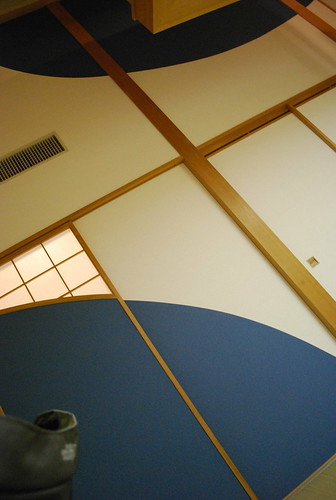
There is something about the architectural aesthetic that appeals to me: sliding doors instead of hinged ones. No wasted space. The door slides in front of another or into a pocket in the wall. This style of construction was made popular in the south of the country, where (as William Ferguson touched on in Hitching Rides with Buddha) the oppressive summer heat necessitates the ability to lay one’s house fully open so that what little wind there is can blow right through. Despite the cooler summers making such features unnecessary in Hokkaido, these architectural hallmarks have nonetheless persisted in the north of Japan. With all the sliding doors in the apartments and houses here, you never really have to commit to having a wall or a door in a given place.
Despite how flexible a set up this would seem to be, there is still an undeniable finality to a sliding door/wall. A hinged door, even when locked, is always an exit or an entrance. You can bolt it with as many latches and chains as you like, but as long as the knob and the doorframe still exists, it is still a door. Were you to lock a prisoner in that room, the hinged door would live on as a small area of hope in the prisoner’s mind. Even if the knob never turns and that door never opens again, it will always represent that possibility.
When a wall slides shut, it can give the illusion of a room without escape. The madness of it is multiplied when the handle for the door is small or hidden. Someone unversed in this design could likely die in an unlocked room like this: pounding on the walls, but never thinking to try sliding one of the walls out of the way.
All this came on at my high school when I first noticed the large, almost blast-door-like sliding walls that exist at the threshold to each of the three floors. Those doors could be slid shut, and where there once was a whole floor, there would only be a wall. These hold particular significance in my high school as I know this is the last year it will accept a new class. Next year the ichi-nensei (grade 10) will transition to ni-nensei (grade 11), and the ichi-nensei will cease to exist. The school, which already has so many derelict classrooms, will have even fewer students. I can picture it starting to shut up on itself, sealing off wings and class rooms that have sat idle for so long as to collect thick layers of dust. I dread when they close up the third floor—the third floor that I only just discovered. It houses a computer lab and a library, but its most alluring feature is the stunning view it provides of the Furubira valley below the school’s hillside setting.
Strangely, this image of the various wings of the school closing up is far more final and moving than the idea that there won’t be a new ichi-nensei class next year. Perhaps it is because I can already see the eventual outcome demonstrated in the now-closed kindergarten, which is adjacent to the elementary school I visit. Where once there were colourful little rooms filled with colourful little furniture and atomically-powered little children, now there is only a steel wall with one of those maddeningly knobless Japanese doors at the centre of it.
The door is a punctuation mark at the end of the life of the kindergarten: an undeniable, unmovable period.

No comments:
Post a Comment